It’s something unpredictable, but in the end it’s right, you will definitely have the time of your life if you come see the Milburn Stone Theatre’s production of Green Day’s American Idiot. Directed by Lance Bankerd with Musical Direction by J. Andrew Dickenson, this viscerally emotional and hyper-sensationalized production of Green Day’s concept-album-turned musical does not shy away from the traumas encountered by the characters within. A jaw-dropping, fist-pumping, rage-bleeding experience, Bankerd’s vision layered over a talented and dedicated cast brings a harrowing and overstimulating performance to the stage for this show.
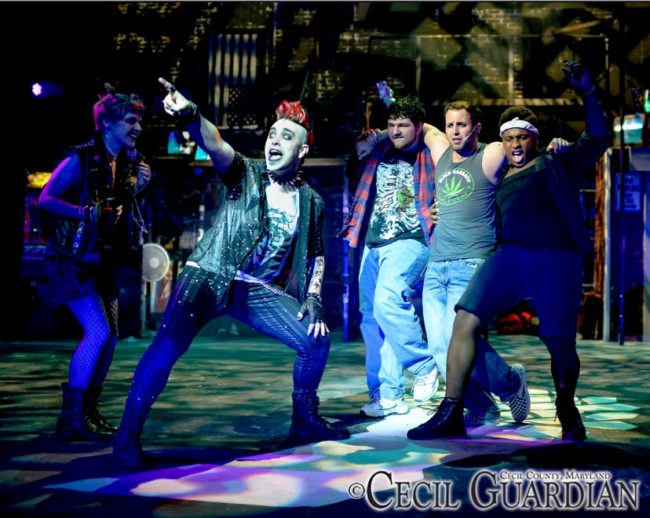
There are very easily three different shows happening on this stage between the narrative storytelling through singing, the loosely-ballet inspired interpretive choreography, and the punk-rock concert borderline psychotic head trip light show extraordinaire. Existing in their own elements, these three components wend and weave themselves around and through each other from the show’s start to finish creating a high-octane contradictory piece of musical theatre artwork that shocks the audience at the core of everything they have— mind, heart, and soul. Simultaneously disjointed and cohesive, much like living with drug addiction or PTSD (two heady topics tackled in the performance) the show surges with the epitome of a punk rock pulse, the essence of emotional disturbia in its energy, and never once falters in its integrity, staying true to both Green Day’s music and the notion of telling a story through musical theatre.
Lighting Designer William A. Price III could easily have his own full-length review for the lighting spectacular that he’s hosting inside the production. Between the harsh intensity of the blinding strobe flickers in the opening number and the roaring blasts of colors that turn the ensemble into shambling rocker-zombies (this happens often in shades of green and blue), Price utilizes his full arsenal of illuminating tricks to accent the show’s wild and unruly nature. Swirling gobos of indeterminately trippy designs as well as blasts of unnatural colors to sharply spike contrasts in mood happen liberally throughout the performance. “Favorite Son” (leading directly into “Are We the Waiting?”) features bombs of red white and blue that blink on and off to fully encapsulate the destructive nature of that war can rain down upon the unsuspecting. The lighting choices throughout are pure spectacle, but Price continues to showcase his versatility by using simplistic focal spotlights for more subdued moments, mainly whenever Johnny takes to playing the acoustic alone.
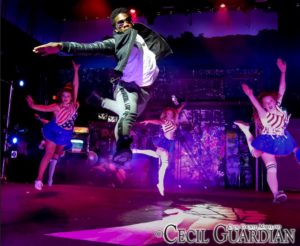
Crawling with the glory of grunge, Costume Designer Lindsay Ellis dredges up a perfectly picturesque punk scene for the couture of the show. Citing a collaborative effort across the board, Ellis showcases the detritus of the glam-rock era that scraped along and snuck into the emo punk scene of the 90’s in each of the ensemble performers individually. All the hallmarks of the stereotypical punk-rock emo-grunge band style are presents as well including the holy thread-shredded jeans, grody plaid, torn fishnets, mismatched leggings and arm warmers, and guyliner. Ellis’ work completes the aesthetic in a fashion most foul, situating the show right at the turn of the 90’s into a war-torn American millennium.
Industrial grime never looked so prime as it does in the hands of Scenic Designer Bob Denton. Exposed graffiti-soaked brick saturated in reactive paint so that when hit with Price’s UV light baths it glows radioactive, in addition to the scaffolding of the filthy city are just a few of the genius fabrications at work in Denton’s design. The ambiguous city skyline filtered in paint across the high top of the back wall is a fitting touch to the escapist nature of the show. Denton, working with Director Lance Bankerd, creates a mobile unit out of the main metal staircase, which when flipped on its end has functioning headlights and pays true homage to stacked double-decker buses, especially once it’s in motion swirling about the stage.
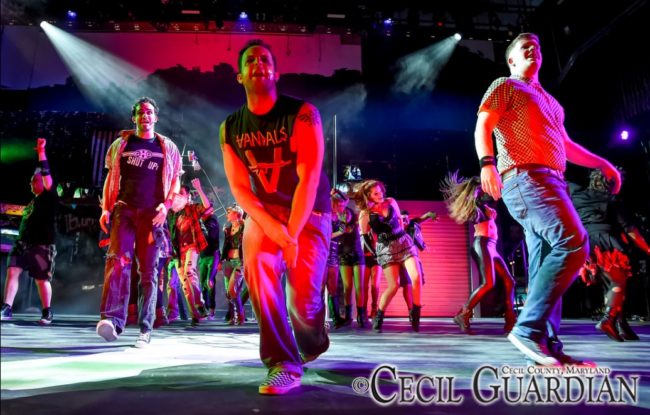
Musical Director J. Andrew Dickenson, who leads the live stage band The Gsus of Suburbias (featuring Dylan Dombroski, Jon Luther, June Suh, Seth Tilman, and Billy Trone), brings an electrifying sound to the show between his thunderous punk band and his ability to make the main trio— Johnny, Tunny, and Will— bleed harmonies when they sing together. Dickenson’s ear is sharply skilled and finely tuned when it comes to balance, knowing how to coax a hard sound out of the band at full blast without overpowering the vocal performances on stage. In addition to this precarious balancing act, Dickenson guides the ensemble through powerful pulsations of sound, keeping them in full equilibrium when it comes to emotional urges pumping against the lyrics of the songs.
Bankerd’s direction is visionary; he delivers a satisfying gut-punch of a show that galvanizes the concept album into something worth talking about. Highest praise is owed to his ability to fully fill the space he’s created, blocking and layering scenes on top of each other in all of the compartments, both elevated and those on ground-level at the same time. Juxtaposing the operatic nature and ballet-influenced dances of Choreographer Ron Jones against Green Day’s music, Bankerd creates a raw exposure of emotions, political injustices, and earnest struggles that impact these characters on a detrimental level.
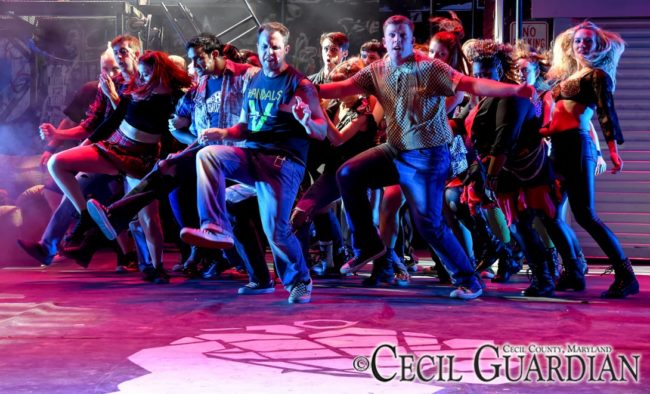
Jones’ choreography aligned into Bankerd’s vision is a mutilated hybrid of pure interpretive dance meeting the verve of musical theatre with a ballet blanket for a costume. Somewhere in the jumbled sequence of “Jesus of Suburbia” (most likely “City of the Damned”) Jones orchestras a distorted triangular marching shuffle line that reads as the bastard child of Les Miserables and Green Day with a liberal dose of middle finger attitude crammed in there for good measure. The staging of “We’re Coming Home Again” reads like Rent hopped up on punk rock Green-Day flavored crack. Moments like these team throughout Jones’ dance routines like infected fish gone viral, which draws together Bankerd’s bizarre but beautiful vision of the show. Jones and Bankerd transform the powerful ensemble into a mishmosh of the vamp core from Rocky Horror Show now live attending a Green Day concert and the result is striking. The blocking and choreography of “21 Guns” is one of the most harrowing full-ensemble numbers in the performance.
With such a forceful ensemble, it’s hard to praise them all for the continual frenetic energy which drives the show, both in voice and in physical movement. Stellar performances from within the nameless faceless crowd of a dozen or so include Brady Fitz, who delivers a truly haunting solo lead-line in “Before the Lobotomy (Reprise.)” The emotional expression that Fitz delivers in this number escalates the savage imagery Bankerd creates by lining up the victims of war one beside the next like meaningless garbage casualties. Ensemble performers Trevor Haupt and Kashana Roberts go head to head vocally in “Too Much Too Soon” showcasing their blasting prowess in this number.
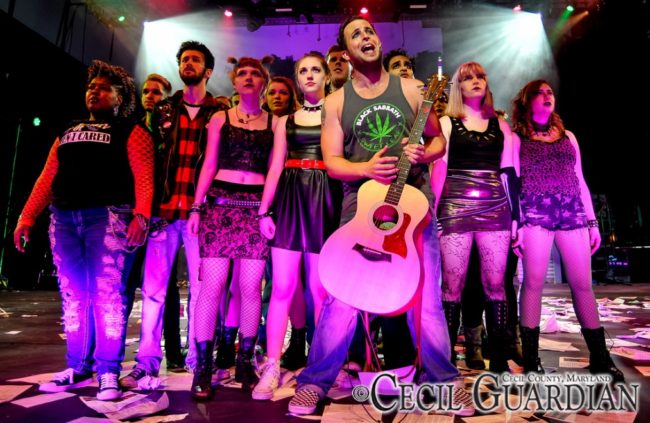
While the show may initially appear to be focused on the three journeys of Will, Tunny, and Johnny, their stories would be incomplete without the women who change the course of their lives. Heather (Charis Latshaw) impacts Will’s storyline directly with her sudden discovery that she is pregnant. Latshaw, like the other two leading females in the performance, brings a powerhouse voice to the table that really belts out her solo features with an earthy feel to them, full of heart and full of passion. “Last Night on Earth” is another moment where her voice is felt in addition to being heard, alongside everyone else performing in that number.
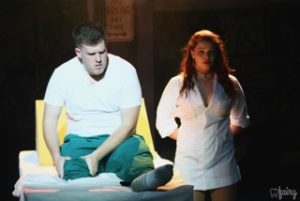
Extraordinary Girl (Lyndie Moe) lives up to her namesake by appearing almost like a dream once Tunny awakens from the terrors of war. Moe has a strong dancing ability, as showcased during “Extraordinary Girl” in addition to being an intense singer. With consistent blasts of high vocal sustain, Moe draws attention to her character in a way that pulls you into Tunny’s story. She is the only female character in the performance whose track exists solely for means of support rather than impact. Moe’s voice is also heard loud and clear in the haunting and truly spine-tingling rendition of “21 Guns” in this production.
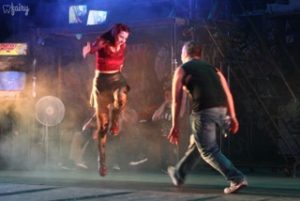
With a name like Whatshername, Darby Elizabeth McLaughlin has her work cut out for her to truly derive any sort of identity from the character’s existence. But McLaughlin rises to the challenge and is not easily shoved down into the masses of the faceless rocker chicks along for the ride. Her first vocal appearance occurs as the anguished echo of Johnny’s tormented existence, only raised up half an octave, in the underscored harmony of “Boulevard of Broken Dreams.” Hearing her eerily serene sound blending against the tortured outcry of his soul in this number melts the brain. McLaughlin’s final appearance, in “Whatshername” is almost as striking as her initial one, layered in white like an angel long forgotten, bringing Johnny one final guitar before she too becomes just a flickering memory.
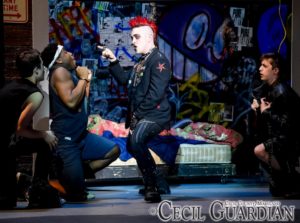
Stealing the show with his crash-landing onto the scene from beneath the aluminum garage door, St. Jimmy (Shane Lowry) is a force to be reckoned with. Physically frightening to behold, almost to the point of engaging the imagination to smell the hellfire that might be seeping from his pores, Lowry is a gritty punk-rocker demon, particularly when he rages and barnstorms the stage for “Know Your Enemy.” Addiction personified and incarnate, Lowry is gripping in his portrayal of the split-persona from Johnny’s mind. Watching Lowry play against Brendan Sheehan (leader of the pack Johnny) is like watching a death match between the two forces of a single man played out by two insanely intense actors. Lowry’s performance is phenomenal, surprisingly versatile, and like one of his many songs indicates, he makes it rain, attempting to seize control of Johnny again and again with his addictive detrimental vices.
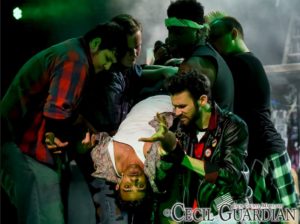
Will (Abu Akki) and Tunny (Matthew Peterson) make up the other two thirds of the leading trio. Akki, whose voice is the mildest of the three, relies heavily on his ability to physically express what it is he’s feeling, particularly in the earlier numbers when he makes a game-changing decision to split from the group. His storyline comes to a head early on with his heart-wrenching rendition of “Give Me Novocain.” Clear of voice and emotional intention, this number, as well as his third of “Wake Me Up When September Ends” linger in the mind’s ear like the ghost of a trauma that just won’t quit.
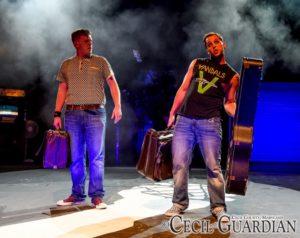
Peterson makes a dynamic shift in the show’s tone when he sings “Are We the Waiting?” And although this number primes the audience for his uncertainty, and in the grander scheme of things the uncertainty of Americans who willingly ship themselves off to meaningless wars, his follow-through arising in “Tunny Awakens” and “Before the Lobotomy” is terrifying. Watching Peterson’s performance in these moments is truly one of the most difficult things to palate in the entirety of the show because he is so honestly invested in showcasing the character’s struggles and pains of accepting what’s happened to him without ever really understanding why. “21 Guns” and “Wake Me Up When September Ends” calls Peterson, and the other portion of the trio, to sing through the fractured fragments of their soul, and much like the soldier inside his character’s heart, he heeds the call with all he’s got.
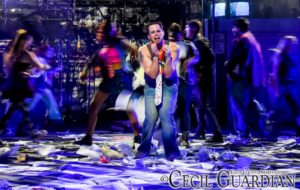
It all comes down to main man Brenan Sheehan. The transformative journey that Sheehan takes as Johnny is astonishing. A remarkable convergence of emotions and ideas coming to a head under his exceptionally talented voice, Sheehan is a sensation of epic proportions in the role of Johnny. Dynamically versatile in his portrayal, Sheehan is able to shift from slow, smoldering sentimentally fused numbers like “Last of the American Girls” to a raging waterfall of emotional turmoil for “Holiday” effortlessly. The raw vulnerability he exposes in the character arc of Johnny is extraordinary, reaching out and gripping the heart with his emotionally charged hands. Playing the acoustic live, Sheehan turns the instrument into an extension of his heart and his voice, often in an anguished vein. The jarring shift that Sheehan executes in the penultimate number, “Whatshername” is a paralyzing recall of solemnity and heartbreak with a gentle undercurrent of nostalgia, which by comparison to the way Johnny rages in the rest of the show is truly something to behold.
There are so many genius things happening in this force of performance that one cannot simply list them all (or you’d be reading into oblivion longer than the show’s physical run-time.) The simple solution to discovering greatness in live theatre is to go and see it. Don’t be an American Idiot and miss your chance to see American Idiot live at Milburn Stone Theatre this June.
Running Time: 90 minutes no intermission
American Idiot plays through June 19, 2016 at The Milburn Stone Theatre— 1 Seahawk Drive in North East, MD. For tickets call the box office at 410-287-1037 or purchase them online.
